Global experience. Рубрика в журнале - Economic and Social Changes: Facts, Trends, Forecast
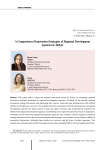
A comparison of innovation strategies of regional development agencies in Turkey
Статья научная
This paper aims to assess the regional innovation system of Turkey by comparing regional innovation strategies developed by regional development agencies. Focusing on the specific regional innovation strategy documents and addressing first, reports, researches and publications on the official websites of the agencies, and next, the in-depth interviews conducted with the representatives of regional development agencies by phone and/or e-mail, the paper examines and comparatively evaluates the efforts of the regional development agencies contributing to the regional innovation system. Comparative evaluation reveals that some regional development agencies have created a specific regional innovation strategy whereas the others have not yet developed such strategies, but conduct various studies on different innovation dimensions, although these studies are exclusive and far from a holistic approach. The comparative evaluation also reveals that regional innovation strategies differ in terms of regional priorities. Nevertheless, similar strategies developed by regional development agencies address the following issues: developing the research and innovation culture; research and innovation infrastructure; institutional structure; human resources; financial resources; effective communication, cooperation and coordination; entrepreneurship and innovation ecosystem; awareness of innovation activities; clusters; priority sectors; social innovation; intellectual property rights and commercialization. Although there are some efforts to improve the regional innovation systems by regional development agencies, the comparative evaluation demonstrates that they have not yet reached the desired level of producing a holistic regional innovation strategy and they should be more effective as a key actor in the regional innovation systems.
Бесплатно
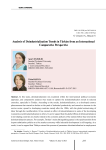
Analysis of deindustrialization trends in Turkiye from an international comparative perspective
Статья научная
In this study, deindustrialization was examined within the international political economy approach, and comparative analyzes were made to explain the deindustrialization trends in selected countries, especially in Turkiye. According to the results, deindustrialization, as a developed country phenomenon that started to decline at the peak of industrial productivity and caused an increase in the service sector, spread to developing countries mainly after the 1990s, with the global restructuring of labor through the neoliberalizm. It has created an effect of industrialization in some of the developing economies and deindustrialization in others. It can be argued that the global effects of deindustrialization in developing countries are closely related to the economic policies of the nations before they entered the deindustrialization process. For example, Turkiye’s main distinguishing aspect is the rapid transition from import substitution policies to a free market economy, while industrial development is still ongoing. As a result, it can be argued that Turkiye entered the process of premature deindustrialization in employment in terms of a direct transition from agriculture to the service sector and the inability of the service sector to absorb the labor force emerging from agriculture and industry, but this is a non-structural phase that can be overcome with alternative socioeconomic and spatial planning.
Бесплатно
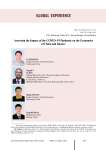
Assessing the Impact of the COVID-19 Pandemic on the Economies of China and Russia
Статья научная
The COVID-19 pandemic has significantly affected economic development in countries around the world. It aggravated existing problems and increased the demand for economic transformation, modernization and qualitative development, triggered a new technological reform, which led to the emergence of new economic business forms and new consumption. The article assesses the impact of the COVID-19 pandemic on the economies of China and Russia. To achieve this goal, we review the state of business activity in the manufacturing and non-manufacturing sectors of the national economy, and summarize the main measures of the anti-pandemic policy implemented by the Chinese and Russian governments. We look into the dynamics of functioning of offline economic spheres that are aimed at personal communication (tourism, catering, retail, transport, culture, entertainment), as well as online spheres implying human-computer interaction (electronic retailing, express delivery, remote work, telemedicine) in the context of the COVID-19 pandemic. We make conclude that the extent of COVID-19 impact on the economy depends on the effectiveness of measures for its prevention and control. We are convinced that at the moment it is necessary to correlate these measures with economic and social development policies, and take into consideration increased consumption as an important aspect of mitigating the effects of COVID-19, accelerate the transformation and modernization of traditional industries, actively develop new economic business forms and build a more open monetary circulation both within the country and globally, thus enhancing the role of the state in global supply chains.
Бесплатно
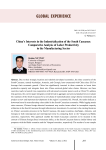
Статья научная
Due to their strategic location and relatively developed economies, the three countries of the South Caucasus, namely Azerbaijan, Armenia, and Georgia, have cooperated with China since 2015 to leverage their economic growth. China has significantly invested in these countries to boost their productive capacity and integrate them into China-centered global value chains. However, are these countries ready to launch into cooperation with advanced economic powers such as China? To address this question, the current paper integrates overall trends in aggregate and sectoral productivity to evaluate the readiness of the South Caucasus for a new phase of industrialization using Chinese investments and projects as new and important developments in the region’s economic life. Overall, the results indicate a downward trend in manufacturing value added in the South Caucasian economies. While lagging trends raise concerns, Chinese foreign directed investment may resolve issues related to incomplete capacity utilization in the South Caucasus through infrastructure investments. In contrast to the existing literature on China’s economic presence in the South Caucasus, this paper examines Azerbaijan, Armenia, and Georgia in both intraregional and interregional terms by comparing them to the Visegrad and Baltic countries, respectively. This approach enables the South Caucasian countries to be situated in the context of Chinese foreign direct investments influx, as the South Caucasus shares a similar history and prospects with the Baltic countries and the Visegrad countries, respectively. The results of a one-sample t-test indicate that, on average, capital deepening and aggregate labor productivity are higher in the South Caucasus than in the Visegrad and Baltic regions. However, manufacturing labor productivity was significantly lower in the South Caucasus than in the benchmark regions. Moreover, the estimated effect sizes at the sectoral level - as measured through eta squared - illustrated the strength of the obtained differences. These findings document the need for improved economic reforms and policies to keep pace with the regions that are driven by foreign direct investments and that have successfully integrated into global value chains. Otherwise, China-led economic development may fail to industrialize the South Caucasus, misguiding the respective parties’ beliefs and expectations. Thus, further research is needed alongside specific sectoral policy strategies to document country- or region-specific challenges related to the increase in Chinese projects and foreign direct investments in the South Caucasus.
Бесплатно

Current problems of cooperation between Russian and Belarusian enterprises: region’s view
Статья научная
Under the unfavorable geopolitical situation, strengthening bilateral cooperation between Russia and the Republic of Belarus is of particular relevance. Currently, Russia is Belarus’ key trade partner. Despite serious challenges, sanctions and restrictions, Russian and Belarusian enterprises continue developing cooperation in almost all sectors of the national economy and achieving results. According to the results of the first 11 months of 2022, the historically maximum volume of mutual turnover of goods and services - 45 billion U.S. dollars - has been achieved. Analytical data and expert assessments show that the current environment makes it possible to intensify bilateral cooperation between enterprises of the two countries and bring it to a new level. On the other hand, as experts note, the existing situation may become a source of problems that hinder the potential of such cooperation. This condition determines the topic relevance and the purpose of the work. The research aims to identify the barriers to cooperation between the enterprises of Russia and the Republic of Belarus and develop proposals for their elimination. In order to achieve this goal, we have developed a toolkit, which was used to conduct an expert survey (indepth interview method) of managers of enterprises of Russia’s region (the Vologda Oblast), cooperating with counterparties from the Republic of Belarus. We carried out the selection of the expert group by means of the documentary method. The heads of six enterprises of the region, whose activities correlate with the structure of the volume of foreign trade turnover between the Vologda Oblast and the Republic of Belarus, took part in the survey. Approbation of the developed toolkit allows identifying certain problems arising in the course of bilateral cooperation: the problem of value added tax refund in the framework of foreign trade operations, the presence of customs restrictions, including on special-purpose products, the negative effects of economic sanctions and others.
Бесплатно
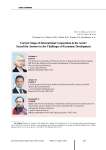
Статья научная
The transformations in the natural and socio-economic environment occurring in the Far North and the Arctic put forward the problem of regional sustainable development. This makes it necessary to address the task of finding strategic approaches to the management of the nonstandard Arctic region, considering the national interests of many states, including the Russian Federation, which dominates territorially in this region. Taking into account the size of the Arctic space and the extreme conditions of economic management, it seems relevant to comprehend the experience of international cooperation in the Arctic and analyze its use for socio-economic development in the entire Arctic region. The aim of the article is to analyze the current stage of international cooperation so as to find answers to the challenges of socio-economic development of the Arctic region. To achieve the goal, we have analyzed the state policy features of the Arctic states based on strategic planning, thus the northern states are able to adapt to the changing natural, socio-economic and geopolitical conditions. We considered approaches in the implementation of projects to develop mineral deposits on the continental shelf of the Arctic Ocean. With the support of international cooperation we give examples of nature management aimed at harmonization of economic interests of business entities and the need to preserve the environment quality in the Arctic. The scientific novelty consists in the critical analysis of the international cooperation features in the Arctic and its readiness to participate in overcoming the new challenges of the Arctic development. The practical relevance of the study lies in the fact that its findings can be used in the educational process in universities, as well as at the state level by executive and legislative authorities in the development and implementation of state policy in the Arctic zone of the Russian Federation, considering the features of international cooperation.
Бесплатно
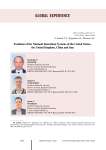
Статья научная
The concept of national innovation systems (NIS) involves consideration of the economic arrangements of individual countries. It is necessary to identify the features of institutions’ evolution that contribute to the processes of creating and transforming knowledge into new technologies and products. The article examines the experience of developing the NIS of the USA, the United Kingdom, China and Iran. The US and the UK have stable and developed NIS with a long history. Thus, Iran and China can be classified as countries with developing innovation systems but demonstrating considerable success. The significant difference between the considered innovation systems is how countries achieve political and economic sustainability. All of them are trying to stimulate market mechanisms for creating innovations. The Chinese innovation model combines the promotion of grassroots innovation and government support for technology enterprises. In the US and the UK, the leading role of business is associated with the perception that it is better at distributing investment in R&D than the Government. Iran is also trying to stimulate private innovation, but the Government still plays the key role because of the limited domestic market and sanctions restrictions. One of the prerequisites for the development of the NIS of Iran and China is a long-term policy in higher education, which, combined with population growth, has led to a significant expansion of access to higher education. The article is of interest to the Russian scientific community since the authors, on the one hand, explore the NIS of the leading countries in the field of innovation located on different continents (the UK, the US and China) and, on the other hand, a country that has been under sanctions pressure (Iran), which is especially important in the current economic and political realities. The authors suggest thinking about possible ways of developing the Russian innovation system by analyzing the foreign experience of the NIS. Scientists who are involved in researching NIS and national innovation policymakers can use the results of this scientific work.
Бесплатно

Статья научная
Social economy (SE) is an economic system that promotes sustainable and inclusive development and makes a relevant contribution with regards to the major challenges facing economies and societies. These are organizations with their triple differentiating characteristics: a) the pursuit of the collective interest of their members, b) the general economic and social welfare interest as they carry out economic and business activities for the market, and c) while meeting the needs of society, generating wealth and opportunities for development at individual and social level. Their primary purpose is social, thus its name, so the social economy enterprises (SEE) requires differential organizational and governance models based on specific values and operating principles. It is precisely this triple dimension and its differential characteristics that produce very positive socio-economic effects, recognized by the different international organizations, the countries and the European Union itself. In fact, the European Union envisages social economy entities as proactive actors in achieving what is known as the triple transition: social, environmental and digital. Recent crises, have led to a profound questioning of conventional growth and development strategies, and a reflection on the role social economy may play due to its double social and economic dimension and the positive impacts it generates, as analyzed in the article. Among others, employment is one of the most decisive mechanisms for a more just and cohesive society, where social economy has a very important role worldwide. So, the European Union Policy and its European Action Plan for Social Economy aim to increase the development of this business model, precisely in order to improve its impact on employment and social cohesion. The article reflects and analyses on these topics focusing on the transformative role of social economy as a key driver of a more just and cohesive society and the triple transition.
Бесплатно
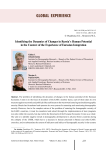
Статья научная
The problem of identifying the dynamics of changes in the human potential of the Eurasian Economic Union is in the focus of attention of the EAEU member states; each of them takes its own measures against economic and political risks and threats on the way toward ensuring national demographic security. Russia has formulated and operates its own systems for assessing and monitoring demographic security. However, due to the complex nature of the problem of ensuring the demographic security of the EAEU countries, it must be considered and solved through the implementation of state programs not only within the country, but also within the framework of the Eurasian Economic Union as a whole. Our aim is to identify negative trends in demographic development in all post-Soviet countries during the collapse of the USSR, which led to a decrease in human potential in Russia and other EAEU countries, and to substantiate the system of indicators and indices of demographic security in the context of Eurasian integration. We consider the resource opportunities that the EAEU countries obtain due to the functioning of a single integration association, and provide the overview of trends, problems and contradictions of integration processes. Based on the comparative analysis of the demographic situation in the EAEU member states, we can talk about the general indicators of crisis changes: a decrease in the birth rate, an increase in mortality, increased mobility of the population, although each country in these years was characterized by its own special dominants reflecting the demographic situation. Our systematic measurements of the dynamics of changes in Russia’s human potential in the context of integration processes, based on the idea of an empirical model of integration, planning and forecasting within the framework of the Eurasian Economic Union, allowed us to identify quantitative and qualitative signs of the functioning of the demographic development of the EAEU countries and develop a number of significant recommendations. The results of the study can be used in the development of the state policy of Russia and the EAEU countries in the field of ensuring the stability of demographic security in the conditions of integration.
Бесплатно

Impact of remittances on the trade balance in the countries of the South Asian region
Статья научная
The present study empirically examines the relationship between trade balance and remittances in five selected countries of the South Asian Association for Regional Cooperation (SAARC). Besides the joint impact of remittances on the trade balance, the individual impact of remittances on Bangladesh, India, Sri Lanka, Pakistan, and Nepal and comparison among these countries are also provided. To conduct this analysis, annual data of 20 years from 1991-2019 were collected from World Bank and Penn World database. Pooled OLS, random effect, and fixed models are used to estimate the joint impact of remittances. Further, dummy variable interaction models are used to estimate the individual impact of remittances on five South Asian countries. Our panel regression analysis confirms the increasing impact of remittances on the trade deficit of five South Asian countries by triggering import-led consumption expenditures. Other control variables, exchange rate, foreign direct investment, investment, and human capital have a significantly negative impact on the trade balance. On the other hand, rent has a significant positive impact on the trade balance of SAARC countries. Dummy variable interaction model confirms the negative impact of remittances on India, Nepal, and Pakistan, while remittances have an insignificant impact on Bangladesh and Sri Lanka. The paper provides various policy impactions for SAARC region.
Бесплатно
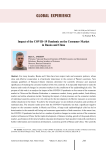
Impact of the COVID-19 pandemic on the consumer market in Russia and China
Статья научная
For many decades, Russia and China have been major trade and economic partners, whose close and effective cooperation is of particular importance in the context of Western sanctions. New strategic guidelines of Russian-Chinese relations determine the scientific relevance and practical significance of studying the consumer markets of the two countries. It is especially important to study the features and trends of changes in consumer markets in the conditions of the epidemiological crisis. The purpose of this work is to analyze the impact of the COVID-19 pandemic on four areas of the consumer market in China and the Russian Federation: e-commerce market, luxury goods market, food delivery market and online education market. Studying the impact of crisis processes on the consumer markets of individual countries seems to be very relevant for the development of effective measures to overcome similar situations in the future. To achieve the research goal, we use methods of analysis and synthesis of statistical data. The research results prove that the COVID-19 pandemic has had a significant negative impact on the consumer market in Russia and China. A large-scale epidemiological crisis has led to deterioration in the material well-being and consumer opportunities of both countries. At the same time, the COVID-19 pandemic has also led to a number of positive changes in certain sectors of the consumer market in Russia and China: further rapid development of distance trading, growth of the goods delivery market, acceleration of the trend of online education development. Such positive trends will contribute to further information and innovation development, economic growth of Russia and China. The scientific novelty of the research is to identify the consumer market areas that have felt the greatest impact of the pandemic in terms of accelerating their development, as well as a comparative analysis of these areas in cross-country comparison.
Бесплатно
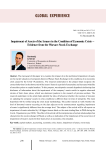
Статья научная
The main goal of this paper is to examine the impact of on the performed impairment of assets on the market valuation of companies listed on Warsaw Stock Exchange in the conditions of an economic crisis caused by the Covid-19 pandemic. The research undertaken in the project helps recognize the correct behaviour (in the short term) of the issuers' shares in a period of uncertainty and increased volatility of securities prices on capital markets. To this purpose, was adopted a research hypothesis indicating that disclosure of information about the impairment of the company's assets results in negative abnormal returns of their share prices, which was dominant position in the research of previous authors. The research undertaken in the article helps identify the rules of behaviour whether the reaction of investors on updating the company's assets in crisis conditions is different than in times of prosperity. The main hypothesis will be verified using the event study methodology. The author intends to verify whether the level of abnormal returns occurring on the days adjacent to the announcement regarding impairment of assets is significantly different from the average level. The subject of the article will be all reports on impairment of assets submitted by 140 biggest issuers listed on the main trading floor in WSE during the Covid-19 pandemic (year 2020). The effect of the article will be interpretation of certain relationships that characterize the stock exchange in Poland as well as an indication of the importance of the occurrence of impairment of issuers' assets for their share prices in economic crisis situation.
Бесплатно
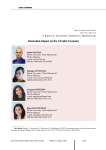
Innovation impact on the circular economy
Статья научная
The paper presents the arguments and counterarguments used in the scientific discussion on the issue of how innovations affect the circular economy and whether it changes accordingly. The main purpose is to analyze the extent to which EU member states manage to boost the circular economy through investment and employment. Review of literary sources and approaches for solving the problem of the multilateral and two-way impact of innovation on the circular economy indicates that the green economy could not exist without the development of innovation, but on the other hand they are its engine. Environmental practices show that there is a need to develop new business models taking into account functionally related innovative changes. The research methods and methodology covers the period from 2008 to 2018. The paper presents the results of an empirical analysis examining the extent to which EU member states manage to boost the circular economy through investment and employment, which showed that measures to increase their economic activity should be in line with the policy of attracting of investment in the circular economy. The research empirically confirms and proves that there still exist certain problems hindering the full implementation of the circular economy; and they are due to the consciousness of the population and employment opportunities in these areas, despite the efforts of the responsible institutions. The results of the research can be useful for public institutions dealing with the circular economy, as well as for the business sector.
Бесплатно
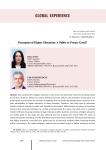
Perception of higher education: a public or private good?
Статья научная
The social benefit of higher education is one of the most important reasons for its being funded by the state. However, within the context of liberal economic policies, the perception of education as a private good and, therefore, the necessity of supplying it by the market has brought about a decrease in the state participation in higher education in many countries. Therefore, this study aims to determine whether students studying at public and foundation universities, differentiated according to financing, perceive their university education as a public or private good. In a sense, this study aims to examine whether different financing methods in higher education affect students’ perception of higher education as a public good. In this study, the data collected from the students were tested within the scope of structural equation modelling, and the hypotheses put forward were confirmed. This study demonstrated that higher education is perceived as a public good by all university students whose financing method differs. According to the results obtained, students who are direct buyers of higher education services in universities that differ according to the financing method do not differentiate in terms of perceiving higher education as a public good.
Бесплатно
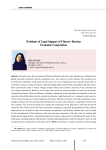
Problems of legal support of Chinese-Russian economic cooperation
Статья научная
In recent years, the economies of China and Russia and their trade relations have withstood the global economic downturn and the pandemic tests. The volume of trade between the countries has exceeded the 100 billion USD mark for three years in a row. Cooperation has expanded from trade to investment, finance, energy, aerospace, high technology, high-speed railways, agriculture and other areas; from cross-border trade to major strategic projects where the economic interests of the countries are very closely intertwined. However, at the same time, there are certain problems in trade and economic cooperation between China and Russia, including a slowdown in the economic development of the two countries, flaws in the trade structure, system mechanisms, legal framework, etc. Alongside a slow recovery of the world economy and a rapid expansion of Chinese-Russian economic and trade cooperation, these problems hinder the free and favorable development of trade and economic cooperation between the two countries. The aim of the study is to examine the experience of the European Union and the North American Free Trade Area in the field of economic integration, especially the guarantees of the relevant legal systems in the field of trade and economic cooperation, and identify whether they can be useful for the development of Sino-Russian trade and economic cooperation. We show that by creating and improving the legal system, modernizing bilateral investment agreements, intensifying the study of free trade zones, strengthening the link between The Belt and Road Initiative and the Eurasian Union, as well as improving the cooperation mechanism of the BRICS countries, it is quite possible to provide legal guarantees of Chinese-Russian trade and economic cooperation. The main methods used in this work are empirical research, case analysis and comparative analysis.
Бесплатно
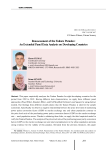
Reassessment of the Todaro paradox: an extended panel data analysis on developing countries
Статья научная
This paper empirically analyzes the Todaro Paradox for eight developing countries for the period from 1992 to 2019. Having different data characteristics, we apply three different panel approaches (Fixed Effect, Random Effect, and Full Modified Ordinary Least Square) by using distinct models. Our findings from different models depict that the Todaro Paradox is valid for the sample economies. Specifically, we observe a negative relationship between the price level ratio of purchasing power parity conversion factor (GDP) to market exchange rate and urban population contrary to the price level ratio of the purchasing power parity conversion factor (GDP) to the market exchange rate - rural population nexus. Thanks to obtaining these links, we apply the third empirical model to verify the Todaro Paradox. The analysis of the price level ratio of the purchasing power parity conversion factor (GDP) to the market exchange rate and total unemployment in the urban population provides strong evidence for the validity of this paradox. Deviated from the previous literature, this paper applies the price level ratio of the purchasing power parity conversion factor (GDP) to the market exchange rate since the higher the purchasing power parity of a country, the lower the rate of rural-urban migration is expected. By using one extra variable (unemployment), we test the Todaro Paradox. This combination of variables as well as different panel techniques (Fixed Effect, Random Effect, and Full Modified Ordinary Least Square) allow us to draw more robust conclusions. To address the challenges posed by rural-urban migration, policies should be designed to promote sustainable development in both urban and rural areas. This can include measures to create employment opportunities and improve the quality of life in both areas, as well as policies to regulate migration and manage the pressures caused by rapid urbanization.
Бесплатно
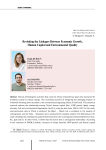
Revisiting the linkages between economic growth, human capital and environmental quality
Статья научная
Various anthropogenic activities that cause the release of greenhouse gases have increased the problems caused by climate change. The increasing necessity of mitigating the damaging impacts of worldwide warming draws attention to the environmental degrading effects of fossil fuels. This empirical research explores the relationship among China’s human capital (lhc), GDP growth (lgdp), energy intensity (lei) and environmental degradation (lco2) by using the data from 1990 to 2019. In this study, macroeconomic data of China is analyzed; the Bayer - Hanck test is employed in the analysis of cointegration, and the Toda - Yamamoto test is conducted for causality analysis. The following are the study’s findings: the cointegration analysis shows that there exist a cointegrated relationship between lco2, lhc, lgdp and lei. In other words, it shows that the factors have a cointegrated relationship. According to the outcomes of FMOLS analysis, increases in energy intensity, GDP growth, and human capital increase carbon dioxide releases in the long term. As evidenced by the findings, improvement in energy efficiency is associated with favorable outcomes for the environment, though economic expansion and the augmentation of human capital are linked to adverse effects on environmental conditions. The Toda - Yamamoto causality test has yielded results indicating the presence of causality links between human capital and carbon emissions, as well as between human capital and energy intensity. Furthermore, it has been observed that the former variable exerts a unidirectional influence on the latter. There is also a unidirectional causality from all variables to carbon emissions, GDP growth and energy intensity, respectively.
Бесплатно
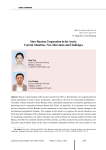
Sino-Russian cooperation in the arctic: current situation, new directions and challenges
Статья научная
Russia's chairmanship of the Arctic Council from 2021 to 2023 provides new opportunities for China and Russia to deepen Arctic cooperation, especially on the issue of “sustainable development”. Therefore, further research on Sino-Russian Arctic sustainable cooperation is of positive significance for deepening Arctic cooperation between Russia and China. In particular, it is necessary to re-examine the new directions of Sino-Russian Arctic cooperation in the context of today's drastic changes in the international geopolitical situation. The purpose of the article is to analyze the current situation, new directions and challenges of Sino-Russian Arctic sustainable cooperation and to provide concrete paths for deepening cooperation. To achieve this goal, the article analyzes the national policies of China and Russia, identifies the common interests of both countries, and then analyzes the current situation, new directions and problems faced by the Arctic sustainable cooperation between the two countries in the context of the reality of the Russian Arctic region. The innovation of this article is to provide a new path for deepening Arctic cooperation between the two countries based on the perspective of Chinese scholars and a more comprehensive understanding of China's Arctic policy. The significance of this article is that the research content and conclusions can be used to promote the process of Arctic sustainable development cooperation between the two countries at the social and even national levels.
Бесплатно
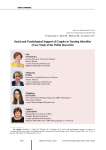
Статья научная
According to the World Health Organization (WHO), nearly 60-80 million couples worldwide struggle with infertility - inability to conceive a child without medical assistance. Infertility is a relevant medical, social, socio-psychological, and demographic problem that negatively affects the demographic situation across the world. In this regard, assisted reproductive technologies help. Infertility diagnosis and treatment is a lengthy and burdensome process, and patients need socio-psychological support while going through it. The purpose of the study is to analyze the situation with the treatment of infertile couples using assisted reproductive technologies in the Republic of Poland and the Russian Federation in the context of the perception of socio-psychological support provided to couples (case study of the Polish research). We used sociological methods: in particular, the author’s own questionnaire and R. Schwarzer and U. Schulz’s test psychological methodology for assessing a respondent’s subjective perception of socio-psychological support. The study involved 39 couples treated for infertility. The majority of respondents (27 couples; 69%) were married. Most female (32 women; 82%) and male (31 men; 79%) respondents did not have children. The results showed that women need more support than men: women received more statistically significant points on the “support-seeking” scale. According to the study, support of a family and a partner were assessed highly. It was revealed that social and psychological support during infertility leads to a positive effect that provides acceptance of the disease (infertility) and reduces stress and a feeling of a loss. Moreover, social and psychological support has a significant impact on the prevention of mental disorders among people treated for infertility. We conclude that socio-psychological support is important for patients diagnosed with this problem.
Бесплатно
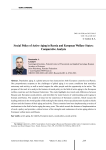
Social policy of active aging in Russia and European welfare states: comparative analysis
Статья научная
Population aging is a global process that characterizes both European countries and Russia. One proportionate response to the challenges of global aging is to create conditions that maximize autonomy and activity, as well as social support for older people and the opportunity to be active. The purpose of the work is to analyze the features of social policy in the field of active aging in the European welfare countries and the Russian Federation. The study highlights key trends and differences between Russian and European social policies, and identifies the main features of understanding active aging in Europe and Russia. The analysis is based on the experience of European countries, which occupy the leading positions in the world quality of life ranking for the elderly, where special attention is paid to elderly citizens and the features of their aging and activity. These countries have been implementing a variety of mechanisms in the field of active aging for many years. The article reveals the features of implementation of such a policy and provides a critical review of the strengths and weaknesses of active aging policies in European welfare states and Russia.
Бесплатно

